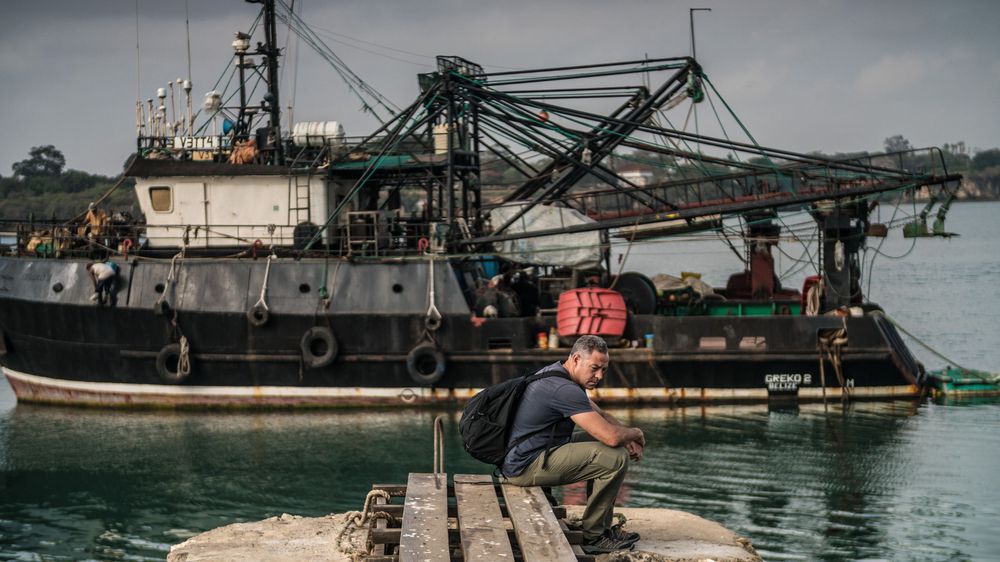A Soundtrack for the Sea: Ian Urbina talks about the musical counterpart to his book ‘The Outlaw Ocean’

It’s approaching almost two years since Ian Urbina’s book ‘The Outlaw Ocean’ was first published, a collection of tales and stories told first hand focussed on crime and extralegal activities at sea.
The book was critically acclaimed and heralded for shining a spotlight on the lawlessness and ruthless behaviour of countries, corporations and individuals performed away from the prying eyes of the public, against the backdrop of the deep blue.
Ian successfully told the story of poachers and pirates, traffickers and smugglers, stowaways and mercenaries, conservationists and oil dumpers. His reporting, often amidst perilous circumstances, has been praised for both it’s ingenuity and approach as well as the results which make for remarkable reading and fascinating insight into what might otherwise be unchartered waters in respect of criminality and illegality. It’s bleak, depressing and unique in it’s innovatiove approach in telling the stories of the waters which connect us all.
The book is set to be adapted into a feature film for which Leonardo DiCaprio and Netflix have bought the rights.
However, this isn’t the side of the story which we are choosing to tell. Instead we want to focus on the corresponding collection of music, and field recordings which have been curated and collated by Ian himself alongside contributions from hundreds of musicians who have attempted to soundtrack the experiences and stories from the book. A unique interaction between music and journalism.
So, describe your own rationale behind the project? What initially inspired it and did the end result change from the initial outlook?
“I’ve been enchanted by the sea since I was a little boy. Spending time offshore always captured my imagination. I was especially drawn to the idea of taking a ship and for weeks crossing this strange and dangerous netherworld that seemed to abide by its own laws of physics. An experience akin to space travel, but on earth. I got my chance, or so I thought, when I was in graduate school and employed as an anthropologist. I took a job on a research trip in Singapore, which, much to my annoyance, ended up never leaving port. So, as a travel experience, it offered little. But spending long days on the dock, I was exposed to the diaspora tribe of seafarers and I was struck by how distinct they were. They were colorful, clever, rutty, irreverent and generally outside the customs that us landlubbers often call law. I knew from them that there was a truly outlandish world offshore and my hope then—and over a decade later when I convinced my editor to cut me loose so I could produce the series that ran in The New York Times—was to explore and chronicle these characters: the traffickers and smugglers, pirates and mercenaries, wreck thieves and repo men, vigilante conservationists and elusive poachers, seabound abortion providers, clandestine oil-dumpers, shackled slaves and cast-adrift stowaways. And, truth be told, once I was exposed to the place and the people, I was hooked.”
It’s fascinating to think that we know so little about the intricacies of our own oceans, what do you feel are the defining lessons that you have learnt from your research and investigation?
“The fish in the sea are running out and as near-shore stocks disappear, boats are having to travel much further from shore to catch a bare minimum, which means that margins for profit are razor slim. As a result, companies and captains, trying to find savings, increasingly are turning to trafficked, debt-bonded and forced labor. More often, these crews are tricked or shanghaied onto boats and never paid when and if they disembark. Meanwhile, consumers in the developed world are ever eager for cheaper goods, including seafood. Governments have scaled back their patrols at sea.
The global economy has become accustomed to tangled and convoluted supply chains where it is very difficult if not impossible (perhaps by design) to discern whether forced labor is being used to move goods across the ocean or catch the fish that ends up on our dinner plates.
The most common model of trafficking is as follows: A poor villager in Cambodia is offered an opportunity for a construction job in (wealthier) Thailand. The villager has no money but the “labor broker” (aka trafficker) offers a travel-now-pay-later opportunity: he will provide transport and line up work and the debt for this service can be settled later. The villager is tricked illegally across the border into Thailand and delivered (much to his surprise) not to a construction job but to a fishing boat. The captain of the boat pays the labor broker the debt that the villager accrued for the travel. That captain now essentially owns this worker until that debt is paid. The villager will be trapped on that boat until the captain says the debt is cleared.
There are hidden costs in the products we consume that travel across the oceans or that are pulled from the seas. These hidden costs include the environmental degradation occurring offshore as well as the human rights and labor abuses of the people doing this work. Globalization has allowed companies to rely on more international and tangled supply chains so as to tap cheaper ingredients and labor. The consequence is savings for consumers but, if we are honest, we also have to admit tacit complicity in the abuses that allow for these cheaper prices – be they a failure to pay workers appropriate wages, a decided policy of unsustainable fishing that is destined to cause stocks to collapse.
It is difficult but not impossible to confront this reality. Seafood may be having its moment of reckoning, not unlike what occurred previously with blood diamonds, sweat-shop garments, and dolphin-free tuna, where companies and consumers say that they are willing to accept higher prices for goods that can actually be traced from bait to plate. Admittedly, because the sea is so far from inspectors and watchful eyes, it will be difficult for companies to track their products better and publicly prove that abuses are not baked into their production process. But if the will is there, companies and governments can accomplish this level of accountability and transparency.”

There can often be a sense of lawlessness associated with the sea, what experiences do you have with such sentiment? What illegality have you observed which has surprised you?
“Perhaps the most disturbing thing I encountered was in a border town along the border between Myanmar and Thailand – the border town was called Ranong. My photographer and I went there because we wanted to look into the way that karaoke bars double as brothels and how they also serve as debt traps, in the sense that migrant men are trafficked from the border toward the fishing docks and sometimes they are held in rooms in karaoke bars. They are often encouraged to run up tabs – interacting with the migrant women, some of them girls, who work there. These migrant men are encouraged to drink and have sex and at the end of a stint they are presented with a considerable tab. Having thought these amenities were on the house since the traffickers (labor brokers) who carry them are the ones who put them there anyways, these tabs are then used to further put the men into debt bondage. The hardest thing that I witnessed was in the karaoke bar in Ranong. A girl who could not have been older than 12 was presented to me and my photographer for sale, not just in the sense of the providing of sexual services but actually the very person of the girl was offered for us to buy. It was one of those moments that when I realized this was a genuine offer and how vulnerable and young that girl was, I was just shocked at the depravity of it all.
I am also perpetually surprised in this line of work by how much people want to tell their own story. As a reporter, I’ve found that if a person sizes you up and decides that you seem trustworthy, they typically will talk.
Sometimes it paid to be coy, other times nakedly transparent. I’m not especially good at the former; I’ve been told that my eyes project information like a ticker tape. When I was in edgy settings like ports, crowded markets, or sketchy neighborhoods where I didn’t want my curiosity, confusion or fear projected so publicly by my face, I wore sunglasses. Mostly, though, I tried to win people over by being bluntly candid, and by having done my homework beforehand so that I could impress the person from the outset that I understood at least a little about their perspective. These tactics served me especially well with fishing captains who tended to be astute judges of character and to have little patience for obfuscation. Getting fishing crews to talk was an art all its own. Silence is core to the way of life on ships, and breaking it can be a dangerous crime. Perhaps the best advice I heard early during my reporting came from a British first mate. “You want to fit in?” he said as we left port. “Take up as little space as possible.” His counsel was less about the cramped living quarters than about the social risk of idle chatter. A respect for this silence, a comfort with it, the ability to use it at the right moments was possibly the single most valuable tool I picked up during my reporting, because it was the key that allowed me to access people and places.
Talking to people who have experienced traumatic experiences takes a distinct carefulness. For example, I had to think hard about how to best approach someone like Lang Long, a man who had recently escaped from a fishing boat where he’d been captive for over a year and routinely shackled by the neck.
I knew in meeting him that this would likely be one of the tougher conversations I would have. And so that he did not trip things up, I warned my translator about some of my tactics: I will sit likely for 15 to 20 minutes in silence at the outset after you introduce me to Long, I told him. I will want you simply to concisely and politely tell Long who I am and that my goal is to capture the story of what happened to him. Then I will shake Long’s hand and you will say that I need to collect my thoughts several minutes before we start. Then we will sit in silence. It will be awkward, I warned, but let it do its work. The point will be to build up pressure so that hopefully Long becomes as eager to talk as I already am. The translator nodded. At some point, I will pull out a pack of chewing gum, I explained. I will put a piece in my mouth and I will also hand you a piece that I need you to chew. This will show Long that it is ok to partake. I will place a piece of gum on the table in front of Long and gently gesture that it’s for him if he wants it. I may just stare aimlessly. I may scribble notes in my notebook. Later, I will get up from the table and leave to get several bottles of water. I will need you to open yours and drink, as I will do the same. Yes, this is all very choreographed and premeditated, manipulative even, I conceded. But it’s also effective in breaking the ice, I’ve found.”
How does music interconnect with the project for you – what do you feel it adds to the overarching theme of lawlessness and your personal experiences at sea?
“It’s hardly surprising that a music project was born from this book, since I used music in various and sometimes oddball ways while reporting offshore. Certain songs were my version of Adderall, helping me focus in distracting conditions. Others offered an incredible salve for deeply dark things witnessed. But perhaps my most valuable use of music while reporting was when songs served for me as mnemonic devices.
When I write I usually listen to music without words. I also cast soundtracks to things I see. On one ship, I watched 40 trafficked Cambodian boys and men work brutally long days, and I remember late that evening, trying to polish my notes and sifting through a playlist that I had of instrumental songs. Was that one scene where the boys ate between shifts more The Leftovers or Ad Astra, I wondered? (I went with The Leftovers for its haunting and weighty sensibility). Capturing the scenes in music was for me a memory aid in that the music was an easier and more efficient moniker for the mood of a moment.
When I looped back later, and tried to build on my notes at the end of a day of reporting, I’d listen to the songs that I tagged to a page of scribblings in my notebook. I’d listen to that song again as I sat down to write the story. The song would come to embody, at least for me, more than my words could. It was a bit like a designed Pavlovian Effect. Each additional time that I’d tie my notes and that scene to that song, it would conjure up images, feelings, an entire setting.
Journalists don’t use music enough to access people. And yet, musicians are masters at telling stories with their songs. Why should movies be the only things that have soundtracks? Why can’t a book have a soundtrack? By pairing two types of creators — a journalist and a musician — around content that is urgent, dramatic, and global, the outcome is music that is tied to something much deeper: a collection of at-sea issues that connect us all.”

Many musicians and artists have attempted to channel elements of the aquatic into their music, Drexciya being a prime example, what role do you feel these field recordings play in the progressive legacy of this?
“I’ve spent the past several years reporting on lawlessness at sea across five oceans, 14 countries and all seven continents. I have launched various initiatives and projects related to it, which are primarily focused on spreading awareness about the environmental, labor, and human rights abuses occurring at sea.
The Outlaw Ocean Music Project is a first-of-its-kind collaboration of such creators. In combining their mediums, these narrators have conveyed emotion and a sense of place in an enthralling new way. The result is a captivating body of music based on The Outlaw Ocean reporting. All of that time spent at sea allowed me to build an audio library of field recordings. It featured a variety of textured and rhythmic sounds like machine-gun fire off the coast of Somalia and chanting captive deckhands on the South China Sea. Using the sound archive and inspired by the reporting, over 300 artists from more than 60 countries are producing EPs in their own interpretive musical styles, be it electronic, ambient, classical or hip hop. Many artists also used the reported footage to make their own videos tied to their song, including Louis Futon, Roger Molls, and De Osos.
These artists have taken a real leap of faith in lending their creative capabilities to help spread this message, try something new and support this journalism. Furthermore, they have produced some gorgeous music. Some artists within decided to choose a theme to inspire their EPs, telling a story, with a beginning, middle, and end. Others focused on conveying an emotion or feeling without necessarily spelling it out in lyrics. All struck the perfect balance between a vast, open, and ‘free’ ocean, and a melancholy, dangerous, and limiting space.
Across all of the artists participating there’s a global audience of more than 90 million, thanks in part to the geographic diversity of the artists participating. In recruiting artists from around the world, the project conscripted an army of cultural diplomats who are talking, in their own language of music, about the weighty concerns facing this offshore realm and the millions of people who work or depend on it. This disparate audience is one that could never be achieved in a traditional journalistic way, and the revenue that the project takes in on our end goes towards the non-profit that funds this reporting.”
So, when asking musicians to compose music which soundtracks your experiences was there a brief offered to them? Do you associate any tracks from the series with specific lived experiences?
“Yes, there’s a brief. All of the music is topically and emotionally inspired by and drawn from issues related to the book. But the musicians are also integrating actual samples (ambient) and sound bites (prose) from the reporting itself. To understand these raw ingredients, think of songs that integrate real-world sounds ranging from Sec. of State John Kerry riffing on illegal fishing to machine gun fire near Somalia or chanting Cambodian sea slaves on the South China Sea. Far more than just a soundtrack for a book, the project is an ongoing tactic for taking ocean issues and messaging them at new and bigger audiences. We allow the artists to have full creative freedom from there.”
There is a wide variety of musicians who have been involved in the project, why did you feel the need to reach a broad range of musicians and artists?
“When it comes to affecting change, tools like news articles, academic journals, documentary films, legal and policy reforms are surely important. But it’s also crucial to leverage culture. Music is a great way to do this because it allows us to more gently message topics with softer more implicit tools (compared to blunter instrument of investigative journalism); it enters a place as spoken in local language by local voices using local vocabulary. Music is celebratory, emotional, shared, and subtle. There is also a powerful multiplier effect here: The success of the music is a success for ocean messaging, a success for empowering local artists by putting them on the world stage, and on the backend in the streaming revenue produced there is a success for the core reporting that our distinct type of journalism that explores, unveils, investigates and explains. The project is a clever way to commandeer music platforms like Spotify and Amazon, turning them into de-facto news outlets. This allows us to message ocean issues at younger people. The music project also allows us to conscript musicians from various places around the world, turning them into cultural diplomats for ocean issues as they do media issues about their albums and engage with their listeners about why they got involved. The project has had considerable initial success and has been covered by NPR, Billboard Magazine, Complex and various other news outlets. The. number of artists and the broad range is not an accident. This project is built to reach the farthest corners of the world while also being able to support more of this journalism. The larger we are, the more impact we can have.”
More details on The Outlaw Ocean Music Project HERE and the book HERE.

















Must Reads
David Holmes – Humanity As An Act Of Resistance in three chapters
As a nation, the Irish have always had a profound relationship with the people of Palestine
Rotterdam – A City which Bounces Back
The Dutch city is in a state of constant revival
Going Remote.
Home swapping as a lifestyle choice
Trending track
Vels d’Èter
Glass Isle
Shop NowDreaming
Timothy Clerkin
Shop Now